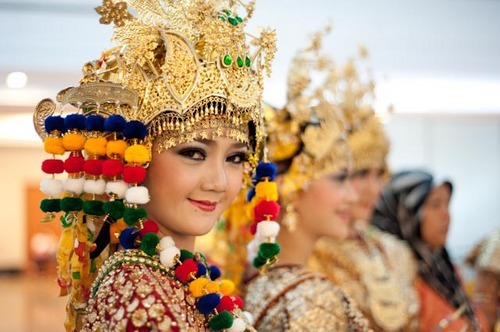Week 13: The Seafaring Peoples of Oceania
Ancient History Resources for Homeschool and Personal Study. This weeks topics: The Astronesian Peoples, Thailand, Ancient Hawai'i and Easter Island. Feel free to customize your study based on which culture interests you most as there are a lot of different civilizations here.
Ancient History is studied through the collection of archeological evidence, written records and oral stories or myths. Just because evidence shows a particular belief or custom was common at a particular time does not mean that everyone in that civilization shared that belief. When you study the topics for this week, you can either go deep on one topic for the week and skip the others or you can do a new topic each day. This outline is just a suggested pace, you can go slower or faster as needed. This outline is intended to provide you with a place to start. You will still need to do your own research.
 |
| Gending Sriwijaya Dancer of Indonesia |
Homeschool Topics for Week 13
Astronesian Peoples
Thailand
Ancient Hawai'i
Easter Island
Discussion Questions
Astronesian Peoples
The expansion of multiple populations, collectively known as Astronesians, by seafaring led to many new civilizations in the Pacific islands. Many people have proposed similar origins of many of these civilizations based on similar language structures. Sea-going vessel technology is one of the greatest technological innovation of the Astronesian people. Astronesian ships had no rudder and were not constructed with any type of metal nail. Many structures on the various islands share the architectural feature of a floor raised on pilings with space underneath the structure for storage or domesticated animals. The word tattoo was introduced by explorers who observed the body painting on people in various South Pacific islands. Another interesting feature of many Astronesians is the use of tannins to dye the teeth black.
Polynesia
The Polynesians are a matrilineal society that settled the islands of Tonga, Fiji and Samoa. The sweet potato, native to South America, was in cultivation on all the Polynesian islands suggesting trade with South American populations. Genetic analysis points to intermingling with the Zenu people of Columbia. In recent times, Mau Piailug showed that non instrument navigation was possible.
Maori
The Maori are the indigenous people of New Zealand. Anciently, the Maori people hunted and ate the Moa bird. This bird eventually went extinct. A largely peaceful people, they used war dances, known as Haka, to frighten attacking tribes and avoid conflict.
Yalomatua
Yalomatua is the Fijian concept of wisdom and experience beyond just mere education. It is the way a person does the right thing morally, ethically and spiritually. Leaders who rule justly and are able to distinguish between good and evil have a high degree of Yalomatua. Conversely, a leader who shows indecision or wrong decision-making shows a lack of Yalomatua. Yalomatua is sometimes defined as the inner strength to pursue and persevere without giving up.
Thailand
Ancient Hawai'i
The Hawaiian Islands were divided into kingdoms, each ruled by a chief, known as an Ali'i, who sought to extend their control over the others. The ancient Hawaiian society was structured in a feudal manner. The four classes, Nobility, priestly, peasants and slaves, were rigid social groups and the only option was to move to the slave group. The rules of the land were called kapu's and to break a kapu was usually punishable by death. The society was geared towards warfare and war was a survival game where the skills of each island were pitted against each other. When two armies met in ancient Hawaii they would form into a crescent shape with the elite warriors known as Koa in the center of the formation. Once the armies faced off there was still a chance that battle could be avoided, although this was not necessarily desirable for Hawaiian warriors. The champions of each army would then come out and fight in individual combat; the out come of their personal fight would then settle the issue. However, when this didn't work a battle ensued
Ancient Hawaiians practiced careful land stewardship. Each chief had control of one watershed area. The land was managed to reduce erosion, and produce food in artificial taro ponds. The fishing area just off shore was also managed carefully. "In ancient times, nearshore reefs were considered part of the cultivated area for food and cared for as if they were extensions of the land. Fisherman knew all the types of fish in their ahupua'a, their habits and food preferences, spawning seasons and migration patterns, and this vast knowledge was passed down through the generations." Click here to hear a Hawaiian explain this ancient Hawaiian practice. Source: "Peace in the Valley" by Grady Timmons published in Hana Hou! Vol 25 no 3 May-July 2022.
Easter Island
Easter Island has the unusual megalithic head statues. The island was originally ruled by leaders who believed in a class system similar to other Polynesian cultures. The statues, called moai, are believed to be erected in honor of ancestors and held spiritual power over the society.
Resources:
